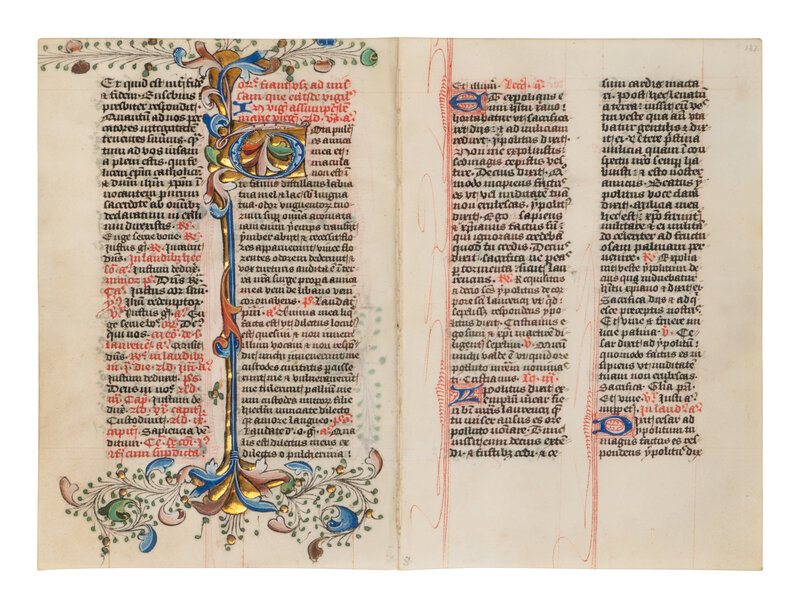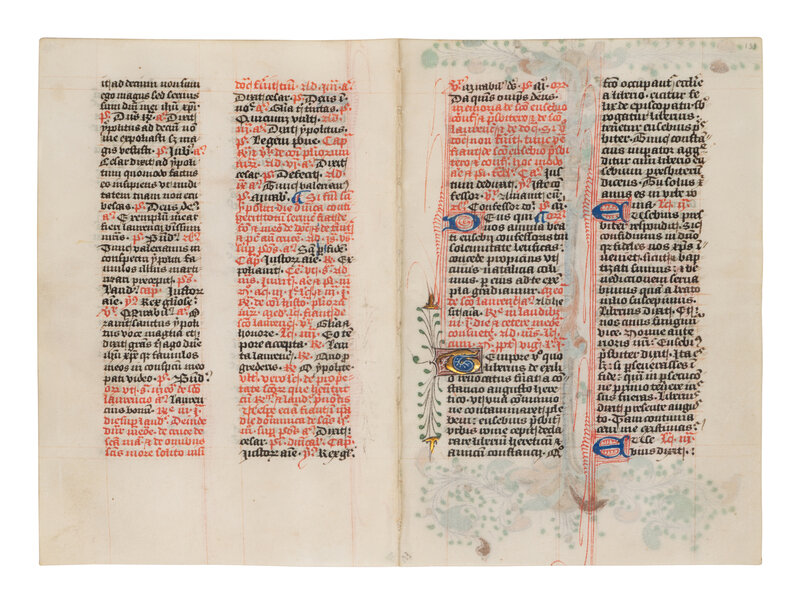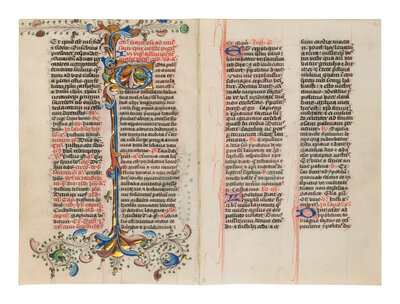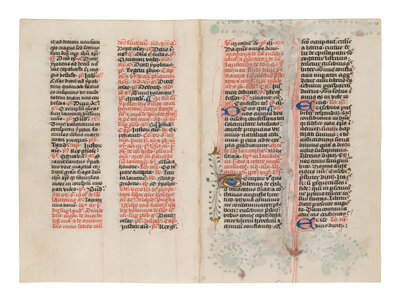Lot 45
ANONYMOUS ENGLISH ILLUMINATOR
A bifolium from a Breviary, in Latin, illuminated manuscript on parchment [England, probably London, c. 1450]
A bifolium from a Breviary, in Latin, illuminated manuscript on parchment [England, probably London, c. 1450]
Sale 2033 - Western Manuscripts and Miniatures
Jun 27, 2024
10:00AM CT
Live / Chicago
Own a similar item?
Estimate
$500 -
1,000
Price Realized
$1,651
Sold prices are inclusive of Buyer’s Premium
Lot Description
ANONYMOUS ENGLISH ILLUMINATOR
A bifolium from a Breviary, in Latin, illuminated manuscript on parchment [England, probably London, c. 1450]
A bifolium from a Breviary, in Latin, illuminated manuscript on parchment [England, probably London, c. 1450]
Sparkling ornamentation from what would have been a luxury Breviary for a wealthy patron.
152 x 102 mm. A bifolium of two leaves from the center of a quire, modern foliation in pencil “132” and “133” in the top outer corner, thus including f. 132-133v, ruled in red for two columns of 35 lines (written space: 108 x 71 mm), written in black ink in a formal gothic bookhand, rubrics in red, paragraphs marks in blue, three two-line initials in blue on red penwork, extending on half the length of the column in long threads of red penwork with dorsal motifs, one two-line initials in burnished gold on red and blue ground with white tracery, extending into floral stems terminating with gold ivyleaves, ONE FIVE-LINE ILLUMINATED INITIAL in blue with elegant white penwork on brightly burnished gold ground, enclosing a spray of fleshy and colored acanthus leaves, extending along the height of the margin into blue and gold bars intertwined with further colored acanthus leaves, spreading in hairline stems in the upper and lower termination on the width of the written space (upper floral border and lower penwork decoration slightly trimmed, else in excellent condition).
This bifolium comes from an as-yet unidentified Breviary copied and illuminated in England in the mid-fifteenth century, of which it was the central bifolium of a quire, foliated 132-133. The text reads on f. 132 from the second and third lessons of the feast of St. Hippolytus and his companions, Martyrs (August 13), part of the Octave of St. Lawrence, continued on f. 132v, and followed on f. 133 with the feast of St. Eusebius, Priest (August 14), continued on f. 133v, and followed with the Vigil of the Assumption of the Virgin Mary (August 15), ending imperfectly on the antiphon “Qualis est dilectus meus ex dilecta o pulcherrima.”
The antiphon of the Vigil of the Assumption of the Virgin Mary opens with a rich initial “T” for “Tota pulchra anima mea.” The extensions of fleshy and colored acanthus leaves on brightly burnished gold grounds are characteristic of manuscripts illuminated in England, and especially in London, in the middle decades of the fifteenth century (compare, for example, leaves from a luxury Psalter, Christie’s, London, 3 December 2015, lot 20).
Provenance
Private collection, California, USA, MS 135.
Sister leaves
Although the parent manuscript is not identified, it is said to have been written for the use of Sarum. The only sister bifolium known is in an American private collection and was loaned for an exhibition at Tampa, University of South Florida, in 2005 (Stone 2005, no. 1, pp. 1-2). It is foliated 185 and offers a similar layout and decoration for the opening of a feast.
LITERATURE
On the sister bifolium, see: Lesley T. Stone, ed. Sacred Leaves. Liturgy & Devotion: Manuscripts from England to Ethiopia, exhibition catalogue, Tampa, 2005, pp. 1-2, no. 1.
Freeman’s | Hindman thank Senior Consultant Sandra Hindman and Elliott Adam for their assistance in preparing this sale.
Property of a Private California Collector
Condition Report
Contact Information



